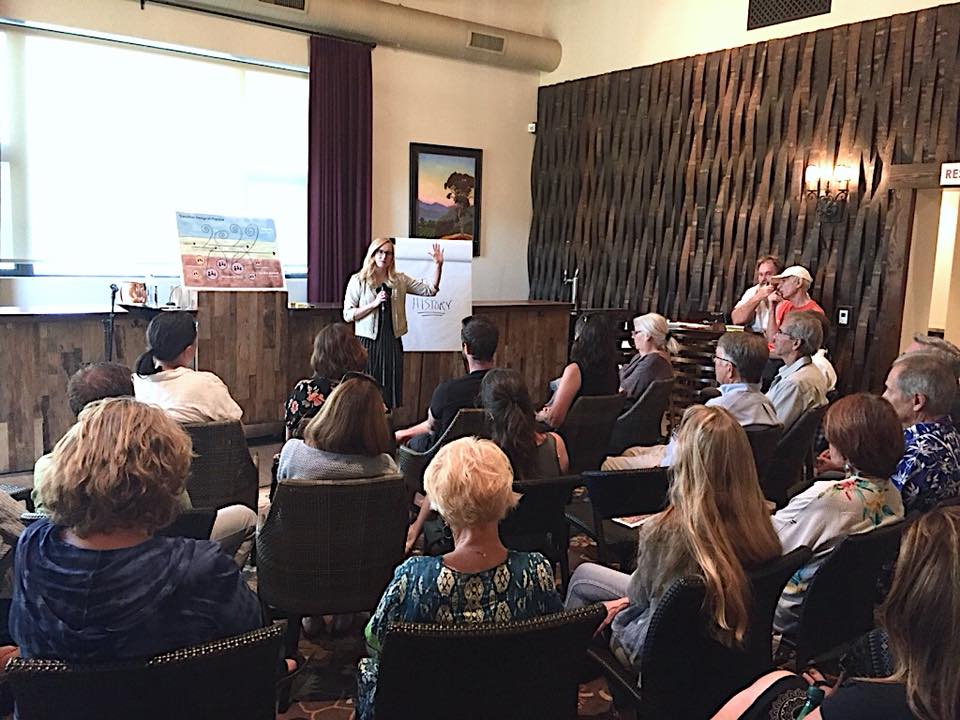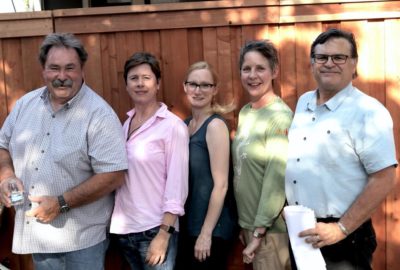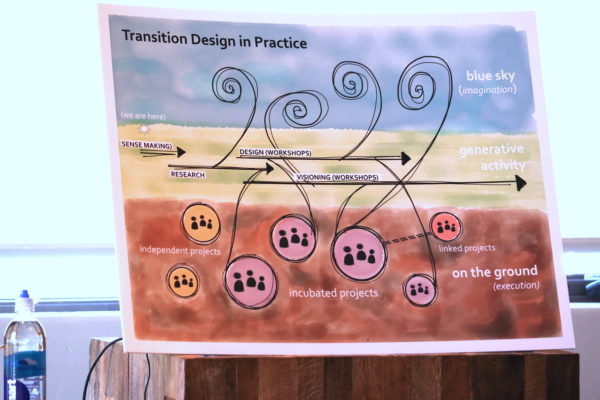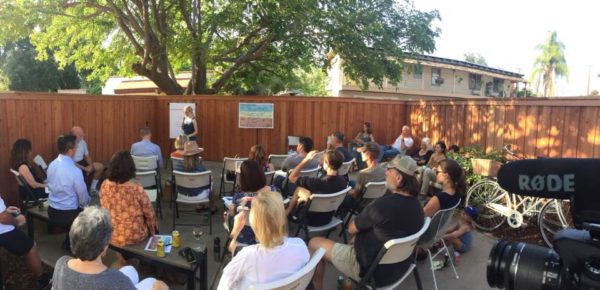OJAI TRANSITIONS | By Keila dos Santos
How Does Transition Design Work in Ojai?
Ojai Hosts FlipLabs in Association with Carnegie Mellon School of Transition Design
How can CMU provide direction to the community of Ojai, its citizens, and the future of Ojai?

Cheryl Dahle of FlipLabs presents to Ojai residents at Topa Mountain Winery. Photo by Ray Powers.
On May 22, the Ojai City Council made a commitment to Carnegie Mellon University (CMU) School of Transition Design regarding the future of Ojai Valley. To follow up on that commitment, Cheryl Dahle, adjunct professor at CMU & CEO/Founder of transition design firm FlipLabs, hosted two meetings on July 31st August 1st, for Ojai residents to talk about Transition Design and how this will play out over the next few years.
WHY OJAI?

Mayor Pro-Tempore Randy Haney, Heather Stobo, Cheryl Dahle, Lisa Casoni & Council Member William Weirick. Photo by Ray Powers.
One of the most key ingredients of transition design is community engagement. Getting people to participate is essential, as the solutions in Transition Design are orchestrated by the community itself. In the case of Ojai, CMU has been considering and hosting small meetings to gauge interest. Turnout at these events has been outstanding. This indicates that our community is ripe to begin the process of unpacking our most pressing issues as a community.
So the question is, how do we move from the place that we are to the place that we want to be?
HISTORY
When most people consider design, we often assume it to mean visual design (interior design, graphic design, etc.). However, designing also plays a significant role in social and environmental matters. Historically, humans have jumped from problem-to-problem offering short-term solutions to immediate issues. Unfortunately, these short-term solutions do not consider the problems we might be creating, in doing so.
The woman who started the program at Carnegie Mellon University is Terry Irwin, the head of CMU’s School of Design. Her vision was simply that we need to train designers differently. Irwin proposed that designers trained in systems thinking could analyze the bigger picture, in the context of society and environment, to solve complex problems. Thus, the school of Transition Design came about.
Terry and Cheryl met at a conference in 2015. By observing Cheryl’s presentation on her work with the global overfishing crisis, Terry realized that Cheryl was using the same approach that they were teaching at Carnegie Mellon. Terry said, “You’re doing transition design!”
To which Cheryl replied, “Oh, that’s great! I thought I was doing ‘You’re crazy and that will never work.’ Ha.”

The Transition Design Model. Photo by Ray Powers.
WHAT IS TRANSITION DESIGN?
The concept is simple and systematic. Transition design is simply acknowledging that the current state is deficient, describing the place we want to move to, then planning how to get there. The entire process is formed by the special characteristics of each community because it is developed by the local area residents.
HOW DO WE ‘DO’ TRANSITION DESIGN?
This system is utilized to overcome some of the most common issues that bottleneck progress. So, it’s important to know and address the ways that best-intended efforts as a community are derailed, despite everyone’s best intentions. The Four Horsemen of The Status Quo (as Dahle refers to them) are:
- Myopia: limited vision about how to solve the problem differently
- Oversimplification: “We need to do this one thing to fix it”
- Fragmentation: duplication, inefficiency, lost opportunities, foregoing existing solutions
- Conflict: understanding things in a binary modality of “right” and “wrong”
According to Dahle, we often make assumptions about the reasons that changes aren’t happening. These four “horsemen” tend to describe the most common disconnects between where we are, and where we want to be. Transition design is a process by which these concerns are overcome.
In successful cases of Transition Design, the shift came from members of the community learning each other’s stories. This is achieved through classic, journalistic style interviews. By connecting the community’s story through these narratives, we can then start to focus on solutions instead of focusing on points of conflict.
WHAT DOES IT LOOK LIKE

Transition Design Meeting held at Porch Gallery, August 2nd, 2018. Photo by Ray Powers.
The first phase that we’ve described above is called, “Sense Making.” Of course, that sounds incredibly vague, but essentially this is where the community shares their own perspectives about the biggest threats, issues and concerns, that they all face.
Once those stories are compiled and aspects of the problem are clearly understood, the team goes into the “Research” stage. Here, the idea is to narrow the issue to its three most prominent threads, mind states, and motivations.
By identifying the problems from multiple perspectives, it’s possible to consider multiple solutions. Some things one might look into are directly relevant examples (exact same problem and its exact solution), complex elements in other places like this local area, or other perhaps other industries and cities that have faced similar concerns.
From here, the process moves into the “Design” phase. Here, Dahle explained, “design” is just a fancy word for creation with intention. In short, they facilitate a process that allows for the community to develop their own solutions, utilizing the data that they’ve collected. According to Dahle, CMU “makes the community the leaders of the work. You tell us what the solutions are. It is you telling us what you need from us, to solve your problems yourself.”
At the start of “Design,” the community first decides on an answer to the question, “What do we want Ojai to look like 20 years from now?” After all, how do we take that deep sense of community, commitment and love that rose from the ashes of the Thomas Fire to make something beautiful happen?
With enough input from the community and through several iterations eventually, the process should uncover the “true north” of the community. “The point of this is not for CMU to park itself in your community and to make money off your problems,” Dahle said.
WHAT’S IN IT FOR CMU (and you…)
So if CMU isn’t coming into Ojai to take over, what are they interested in? CMU is interested in creating an educational curriculum that teaches designers to think differently. Through the process of helping Ojai, student designers get to learn in a variety of ways. They get to see how complex systemic problems are solved by a community and this experience helps to build the body of academic knowledge.
As Dahle explained, “We get to work on impossible problems with extraordinary people who exhibit talent, brilliance and passion. It just hasn’t found the right channels and — what’s in it for you? Some great solutions! You will form deep relationships because of everything you do in this community, to help Ojai become this better version of itself.”
The involvement of CMU and the memorandum of understanding agreed upon by the city council simply provides a platform for CMU to begin seeking out funding opportunities. They can seek out private donors, grant opportunities, and other options to bring money into the valley for local projects.
WHAT HAVE WE DONE?
The commitment to CMU is valid as long as the community of Ojai is interested in participating. Dahle reiterated, “If you guys decide that you don’t want us here, we go away. This type of work is a journey … there are places that will feel really uncomfortable.”
To close, Cheryl poignantly stated, “We can outlast these problems together.”
Councilman Randy Haney said, “Last year, we had STR (short-term rental) debate. If we had this in place, we could have solved this problem that broke this community in half … We’re all in this together but the reality is that we don’t have a collaborative vision about what to do with this community.”

Add a college in Ojai. Junior if not a State University. Learn to use the intellect, be aware of other communities about the world and how they solved problems. Think outside the (Ojai) box!
Increase business and other basic job skills.
My feeling since coming to Ojai five years ago! The same issues are still there, undecided 🤷🏼♀️!